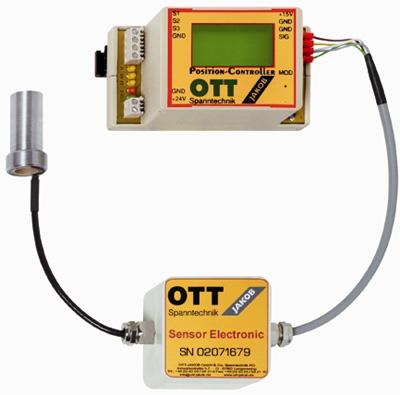
Advanced Machine & Engineering Co. introduces the OTT-JAKOB Position Monitoring System with the Electronic Analog Sensor, which allows you to monitor your drawbar for performance and wear. An electronic analog sensor detects the position and an electronic unit attached to the machine controller transmits the data. This system indicates whether your tools are clamped, unclamped or not present. It can increase tool head accuracy and longevity by monitoring cycles and hours, indicating whether your tools are properly held. Because these units transmit information quickly to the machine tool controls, mechanical signal rings with inductive sensors are now obsolete. Negative influences of the signal rings at higher RPM can therefore also be avoided.
Components of the Monitoring System Include:
Sensor — The OTT-JAKOB unclamp unit contains a cylindrical, inductive analog sensor consisting of a primary and secondary coil. During clamping or unclamping, as the drawbar connection moves axially through the analog sensor, the target ring on the drawbar connection triggers the output signal. The signal increases as the target ring farther enters the sensor, indicating the position. The position is also monitored during the milling process.
Sensor Electronics — The sensor electronics supply the primary coil with constant frequency and amplitude. A demodulator transforms the signal of the secondary coil into a stable DC output signal.
Position-Controller — The position-controller evaluates the current signal and sets the output signals at the adjustable limits. A digital filter compensates existing peak values. The position-controller is equipped with a meter for operating hours and operating cycles.
Contact Details
Related Glossary Terms
- gang cutting ( milling)
gang cutting ( milling)
Machining with several cutters mounted on a single arbor, generally for simultaneous cutting.
- milling
milling
Machining operation in which metal or other material is removed by applying power to a rotating cutter. In vertical milling, the cutting tool is mounted vertically on the spindle. In horizontal milling, the cutting tool is mounted horizontally, either directly on the spindle or on an arbor. Horizontal milling is further broken down into conventional milling, where the cutter rotates opposite the direction of feed, or “up” into the workpiece; and climb milling, where the cutter rotates in the direction of feed, or “down” into the workpiece. Milling operations include plane or surface milling, endmilling, facemilling, angle milling, form milling and profiling.

